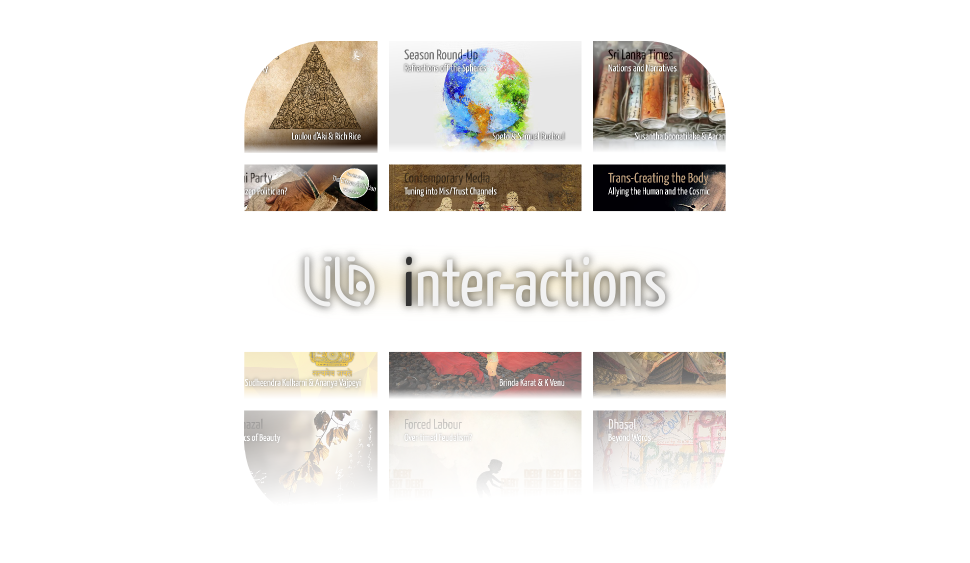

|
|
|
Contemporary Media: Tuning into Mis/Trust Channels
|
|
The Indian Left Front: Recasting the Spiral of Negation?
|
| BRP Bhaskar & Shashwati Goswami |
31 March 2014 |
|
Brinda Karat & K Venu |
24 March 2014 |
Our time, as New Media theorist Dan Gillmor points out, is witnessing the first draft of history being written, in part, by the former audience. We have come a long way from McLuhan’s original moment — we take it for granted that the medium transforms itself into content in the frenzy of events. With the political theatre open 24/7 during the General Elections in India, contemporary media cannot but play out the drama. ‘Ethics’ has long been a museum term in the media world, and it does not surprise us any longer when competent journalists are disgraced and shown the door for taking a stand. In the era of empty rhetoric and ideology sale, what can bring forth a responsible dynamic within the media? In this week’s Inter-actions, BRP Bhaskar assesses the terrain, from dominant mediums to regulatory boards, economic structures to educational institutions. In her response, Shashwati Goswami deplores the entertainment turn taken by most media, and warns against the danger of an imminent fatigue that might render the entire mediascape redundant.  |
|
The history of ideas on the law of negation took a definitive left turn with Marx adapting the third aspect of the Hegelian triad – ‘negation of the negation’ – to refer to the inevitable collapse of capitalist production. Later, Lenin’s spiral history of the world emphasised the continuity of human resistance to oppression. But as the spiral advances, a seminal question emerges: from which centre is its movement drawing power, and in which direction is it continuing? In the pluralistic Indian space, it is vital for the Left to resolve this puzzle through a new imaginary. In this week’s Inter-actions, Brinda Karat highlights the pre-poll efforts of the Left to form a secular democratic alternative to the communal and corrupt forces in politics. K Venu discusses the challenge faced by the Left to transcend the centrality of its spiral of negation, and cast a more dynamic political philosophy: the Left must launch a thorough introspection to connect their democratic inspiration with an organic political, intellectual and cultural practice.  |
|
|
|
Kathputli: A Vision of Urban Reinvention
|
|
Bharatiya Janata Party: Searching the Vital Centre?
|
| Rahman Shah, Puran Bhaat and Tapan Chakravarty |
17 March 2014 |
|
Jaswant Singh and Vidya Subrahmaniam |
10 March 2014 |
Where does art live in our cities? Culture industry ‘appropriately’ labels tangible forms of creativity as ‘arts’ and ‘crafts’, and employs artificial socio-economic yardsticks to separate performance locations. But living art is not bound within the walls of convenience at sites such as Kathputli in Delhi’s Shadipur. The colony has been a cauldron of contemporaneity, a throbbing dream of sustenance for many itinerant artists. Yet today, the all-pervasive ‘urban development’ is forcing hundreds of artists to shift from their self-made neighbourhood into inappropriate dwelling places. Along with Holi colours, this week LILA Inter-actions brings you the passionate voices of two artists from Kathputli. Rahman Shah, magician, contrasts his bright memories of the last four decades with the daily pressures of his practice. Puran Bhaat, puppeteer, reflects on the inadequacies of urban planning, and suggests ways to be inclusive. And, Prof. Tapan Chakravarty widens the picture to discuss the underlying historical and political complexity of Kathputli where art is indeed a dear way of life.  |
|
In his 1949 book, Arthur M. Schlesinger, Jr. coined the phrase ‘the Vital Centre’ to refer to the contest between democracy and authoritarianism. Sixty-five years later, we are faced with an acute political dilemma in India. Are our dreams of liberalism challenged by a growing conservatism within democracy? Or is our democracy itself threatened by a totalitarian movement from without? This is the starkest question that our national political parties are confronting now, as India runs up to General Elections 2014. The problematic seems to be presenting itself more intensely to the Bharatiya Janata Party, with the emergence of an arguably new brand of personality-oriented politics within its own administration. For our second issue of The Citizen Politician debate series, senior leader Jaswant Singh discusses the criticality of following the middle path, and creating a vital centre within the party. In her response, journalist Vidya Subrahmaniam critically assesses the BJP’s claims as a centrist party, and the hurdles that it has to cross before reaching this goal.  |
Disclaimer: The opinions expressed by the writers are their own. LILA Inter-actions will not be responsible for the views presented.
|
Spread the word…
|
|
|
|
|
|
… follow LILA!
|
|
|
|
|
|
|
|
Knowledge is power, and our intention is to bring the power to you. We have initiated a thought movement that aims to strengthen democracy by bringing to you direct voices of important trailblazers and pathmakers, and reclaim deep and patient reflection as an important seed for relevant and sustainable action!
Help us take this movement forward. Support Inter-Actions today for as little as Rs. 100. DonateDonation to LILA is eligible for tax exemption u/s 80 G (5) (VI) of the Income Tax Act 1961 vide order no. NQ CIT (E) 6139 DEL-LE25902-16032015 dated 16/03/2015
![]()

![]()